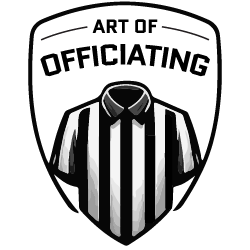Note: This mechanics discussion is for a 5-person crew.
As I’ve mentioned in previous Ready for Play articles, I watch a lot of Hudl film. One error I commonly observe is poor wing official eye discipline and movement during scrimmage kicks.
What is a gunner?
The gunners typically set up between the interior line and the sideline and are often the team’s fastest players. Their responsibility is to avoid the defensive backs assigned to block them and reach the punt receiver as quickly as possible.
Wing scrimmage kick mechanics
Both wings: First, pay attention to the formation to determine which player(s) you’ll observe post-snap (in case Team A fakes the kick and throws the ball downfield). For example, in a balanced formation, the line judge will key on the inside eligible receiver, and the back judge will key on the gunner (on the outside). The line judge must quickly shift focus to the gunner if/when the ball is punted, as the back judge will then shift his focus to the punt receiver.
Both wings: DON’T WATCH THE PUNTER CATCH THE SNAP! From the Hudl video I’ve studied, more than half of the wings stare at the kicker until he kicks the ball. Only after the kick do they shift their eyes downfield. For about half of the scrimmage kick, they are watching the referee’s key, and the gunners and defensive backs are unobserved.
Both wings: When you advance downfield, don’t walk…hustle!
Just a peek: You must determine the height, distance, and trajectory of the ball when it’s kicked, so you are afforded just a quick glance upward at the ball after it is kicked. Then quickly look back at your gunner.
Line Judge: Move downfield as soon as the ball is snapped while watching your key. Again, you don’t get to look into the backfield; if you do, you’re ball-watching. Move halfway between the line of scrimmage and the end of the kick. Get to the halfway point, stop, and then officiate until you must again move. Keep your eyes on the gunner; don’t fixate on the punt returner (that’s the back judge’s job).
Head Linesman: Your job is a little tougher as you must remain on the line of scrimmage until the ball clearly passes the LOS (and will not return). So, you’re essentially 2 seconds behind the line judge on your advancement downfield, and your key (the gunner) will be about 15 yards away when you can move (and moving away at a high rate of speed). If the ball is kicked high and short, remain on the LOS and resist the temptation to stare at the ball. Keep your eyes on your key, who could be 25 yards downfield. (It’s important to note: You don’t give up your key to the back judge. It will seem a little strange that the player you are required to watch is so far downfield.) If the ball is booted deep, don’t dawdle; you have some ground to make up, so get on your horse and move halfway between the line of scrimmage and the end of the kick.
Both wings: If/when your gunner moves past the defender and it becomes a foot race with the gunner preceding the defender, think “this could become a block in the back.” The back judge is watching the receiver, not the gunners, so the wings are most likely to see this foul.
Here is “average” high school scrimmage kick timing and distance:
Snap to kicker: Just under 1 second
Kicker possession to kick: 1 to 1.5 seconds
Kick duration (hang time): 2.8 to 3.5 seconds
Total time from snap to punt receiver: 5 to 5.5 seconds
Punt distance (from the LOS to Team R catching the kick): 35 yards
A typical high school gunner will run 40 yards in about 5 seconds (if unimpeded)
If the gunner is blocked or is prevented from running a straight line to the receiver (as typically happens), the gunner will advance 25-35 yards toward Team R’s goal line before the ball arrives at the receiver’s position.
Quiz
Read the quiz stem and then choose the best answer.
A22 on the line and at the top of the numbers. A80 is close to the interior line and 1 yard in the backfield. All Team A players are set for 1 second. A80 then points to A22, steps forward, and stands directly beside the left tackle. A22 waits for 1 second, then takes two steps backward and immediately goes in motion parallel with and two yards behind the line of scrimmage. The ball is snapped while A22 is in motion.
- Illegal shift
- Illegal motion
- No foul
Review Rules 7-2-6 and 7-2-7
